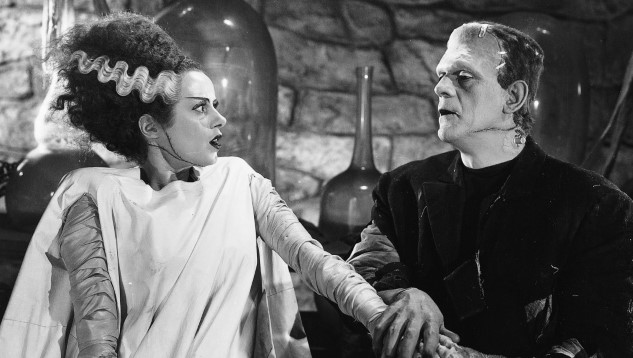
This post is part of Paste’s Century of Terror project, a countdown of the 100 best horror films of the last 100 years, culminating on Halloween. You can see the full list in the master document, which will collect each year’s individual film entry as it is posted.
The Year
After taking a moment to adjust to the sea change represented by actual enforcement of the Hays Code, Hollywood studios return to producing a steady stream of horror films in 1935, led by one of the greatest horror sequels of all time in the form of Bride of Frankenstein. Sequels being more of a novelty at the time, it took four years to revisit Universal’s monster mega-hit, and it would take another four years to return for the third go-round.
This is a pretty balanced year for horror overall, with notable entries in a number of sub-genres. Prominent is Peter Lorre’s excellent starring turn in Mad Love, one of several remakes of The Hands of Orlac, our top film from 1924. Lorre, still newly arrived in Hollywood, is in the midst of being typecast as a psychopath or murderer here, probably stemming from his initial appearance in Fritz Lang’s M, but he would escape that sole characterization before too long when he took on the long-running (but racially questionable) role of Japanese detective/secret agent Mr. Moto. Regardless, he’s wonderful as Orlac, once again fearing that his hands are not his own.
1935 also yields another solid Karloff/Lugosi team-up/Edgar Allen Poe rip-off in the form of The Raven, notably less grotesque than The Black Cat a year earlier thanks to the Production Code, along with influential early werewolf yarn Werewolf of London, which blessed us with the sight of a dapper werewolf in a smoking jacket. Lastly, 1935’s Tod Browning-directed Mark of the Vampire is notable for the fact that it’s the only other film outside of Dracula and Return of the Vampire where Lugosi played a vampire character, although the enthusiasm is somewhat tempered by the fact that the twist ending reveals that the film’s vampires are simply actors pretending to be vampires. This is a bit of plot anachronism you would have expected to see in the 1910s or 1920s, rather than the 1930s, when monsters were being treated as more literal threats, but it makes more sense when you consider that Mark of the Vampire was more or less a sound remake of the famously lost silent horror film London After Midnight.
1935 Honorable Mentions: Mad Love, The Raven, Werewolf of London, Mark of the Vampire
The Film: Bride of Frankenstein
Director: James Whale
The idea that Bride of Frankenstein represents a sequel “even better than the original!” is one that has become so common in the circles of internet film criticism that it almost borders on a modern critics’ cliche, but that doesn’t make the observation any less accurate. In fact, one can point to Bride as evidence of just how far the talky studio system had come in the space of four years, from 1931 to 1935—it’s a significantly more polished, more ambitious movie, made all the stronger by James Whale’s confident and dynamic direction, coming off the likes of The Old Dark House and The Invisible Man. It’s the director’s magnum opus, completed several years before his reluctance to remain in the closet likely contributed to the early end of his career. Much has subsequently been made of the possible homoerotic subtext of Whale’s films, and Bride of Frankenstein in particular, but that’s enough for a separate essay all its own.
Bride picks up directly where Frankenstein left off, as villagers celebrate the supposed death of Henry Frankenstein’s (a returning Colin Clive, better here than in the original) creature in the burning windmill climax of the original film. The monster, of course, is not dead—it survives in a flooded pit under the windmill, although the burn scars it now bears take Jack Pierce’s already impressive makeup to the next level. It soon emerges, scaring the bejeezus out of Frankenstein’s maid Minnie, played with hilariously shrill excess by character actress Una O’Connor. This sort of gallows humor is just one aspect that makes it stand out in a different way than Frankenstein.
After his experience in the first film, Dr. Frankenstein has become disenchanted with the thought of playing God and creating life, and vows to set his work aside to enjoy the peace of married life. That is, until the reemergence of an old colleague, the beguiling Dr. Pretorious, who has been exploring research that runs parallel to Frankenstein’s. With the cunning of a snake, the exceedingly arch Dr. Pretorious—in an all-time villain performance by British actor Ernest Thesiger—succeeds in first tempting and then forcing Dr. Frankenstein into doing his bidding, because “the monster demands a mate!” As Pretorious, Thesiger steals practically every scene, turning the monster into another one of his pawns to be used in pursuit of knowledge and power.
Karloff, meanwhile, initially opposed the idea that the Monster learn to haltingly speak in Bride of Frankenstein, but it turns out for the best, deepening the creature’s sense of loneliness and loss, particularly in the oft-parodied sequence when the Monster befriends a blind hermit in the woods, with ruinous results. Pretorius later uses this turn of events to further needle Dr. Frankenstein, taking credit for his “education” of the Monster, even as he uses the situation to further his own ends. In the end, Bride completes the process of humanizing the creature that is begun in the first Frankenstein, bringing its tragic arc full circle. The only other Frankenstein sequel that can stand in the same company is 1939’s Son of Frankenstein, but it functions more as top-notch popular entertainment than Bride’s sublime examination of the existential agony of existing as a perennial outsider.
Jim Vorel is a Paste staff writer and resident horror guru. You can follow him on Twitter for more film and TV writing.